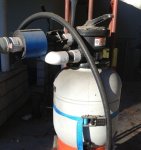So, I've been sitting around pondering my pool, life, house maintenance, etc. In the process I have been wanting to be as proactive as possible about addressing any issues with my pool.
Recently, I ran the full gamut of tests on my IG plaster pool:
FC: 11
CC: 0
TA: 120
CH: 230
pH: 8
CYA: 100
My pH always ran a little high, and I figured that was just a side effect of maintaining high FC levels due to my high CYA. However, I got to thinking that I should work on verifying whether or not that is the case, which lead me into wondering if the splotches on the bottom of my pool is actually calcium scaling.
Ignoring the tree reflection, please regard the splotches:

After messing around with the pool calculator it looks like my CSI is around 0.46, which is getting close to the danger zone it seems like. In short, I think I may be realizing that I simply haven't been adding enough muriatic acid regularly enough. My plan currently, since I live in Texas and don't close my pool (it's just too Dang cold to get in it), is to use the calculator's suggested amount of MA to drop my pH down to about 7.2, and let my waterfall aerate it, and once it climbs back up, then do it again. I'm hoping come summertime I may see a marked improvement on the calcium scaling?
Does this seem like a reasonable plan? I believe all my other numbers seem reasonable (except for maybe CYA, I may consider doing a water replacement come summertime as well). Does anyone have any thoughts or input on this course of action?
Recently, I ran the full gamut of tests on my IG plaster pool:
FC: 11
CC: 0
TA: 120
CH: 230
pH: 8
CYA: 100
My pH always ran a little high, and I figured that was just a side effect of maintaining high FC levels due to my high CYA. However, I got to thinking that I should work on verifying whether or not that is the case, which lead me into wondering if the splotches on the bottom of my pool is actually calcium scaling.
Ignoring the tree reflection, please regard the splotches:

After messing around with the pool calculator it looks like my CSI is around 0.46, which is getting close to the danger zone it seems like. In short, I think I may be realizing that I simply haven't been adding enough muriatic acid regularly enough. My plan currently, since I live in Texas and don't close my pool (it's just too Dang cold to get in it), is to use the calculator's suggested amount of MA to drop my pH down to about 7.2, and let my waterfall aerate it, and once it climbs back up, then do it again. I'm hoping come summertime I may see a marked improvement on the calcium scaling?
Does this seem like a reasonable plan? I believe all my other numbers seem reasonable (except for maybe CYA, I may consider doing a water replacement come summertime as well). Does anyone have any thoughts or input on this course of action?


